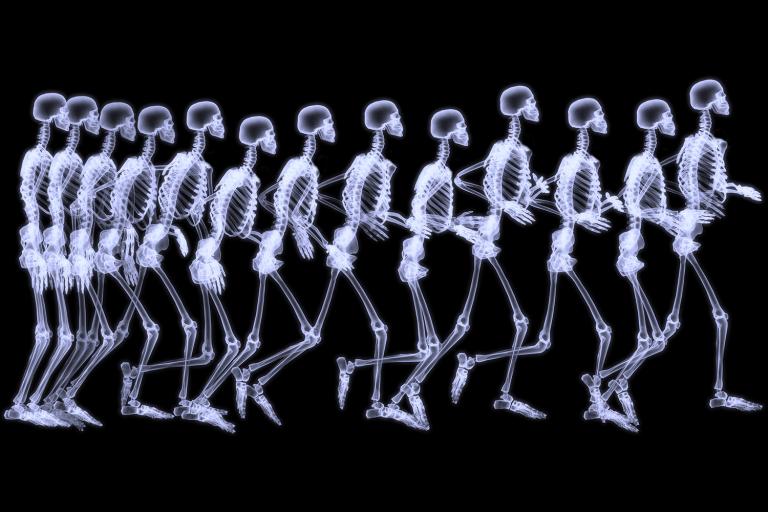Protecting bones from degeneration often seems like the least of our concerns—until they ache. But attention to bone health throughout life will keep your body properly framed, protect organs, and let you move without discomfort as you get older.
Bone Strength and Age
“As we age, we become aware of bone health and the need to take care of our frames. And that’s great,” said Jason Sonners, a chiropractor in Florham Park, NJ. “But most of our bone growth happens before we’re 20 years old. Now, that doesn’t mean it’s too late to take care of your bones, but it’s important to know it really matters early in life.”
Most people reach peak bone mass by 30. That’s why Dr. Sonners and other health experts stress the importance of building bone mass in youth to prepare for the later years of life, when instead of making new bone fast and furiously, our bodies remodel much more slowly. As we age, we lose slightly more bone mass than we gain, opening the door to weak bones and the development of conditions such as osteopenia and osteoporosis.
Maintaining Bone Strength
All people can be better bone stewards by taking two simple steps: eating healthy and exercising as hard as your body allows.
Diets should include vitamins D and K and the minerals calcium and magnesium, while exercise should place some stress on your bones so they won’t atrophy.
-
Diet and Nutrition
The “Milk does a body good” and “Got milk?” advertising campaigns made a lasting impression that the vitamin D and calcium in milk were the best sources to fortify bones. But a 2014 study of more than 100,000 Swedes over approximately two decades found no link between milk consumption and bone fracture risk.
While the once ironclad ties between milk and bone health might now seem fragile because of concerns about fat intake, few people dispute the importance of vitamin D and calcium.
-
Calcium
Our bodies contain more calcium than any other mineral, storing most of it in bones and teeth to keep them strong.
“Many published studies show that low calcium intake throughout life is associated with low bone mass and high fracture rates,” said Steven Hausman, PhD, a researcher from Bethesda, MD, who specializes in immunogenetics and transplantation biology. “Many people in the United States consume much less than the recommended amount of calcium in their diets.”
Sources of Calcium
Good sources of calcium include:
- low-fat dairy (e.g. yogurt)
- figs
- canned salmon
- sardines
- shrimp
- fortified soy milk
- fortified tofu
- almonds
- leafy greens
- broccoli
- Brussels sprouts
- bok choy
- mustard
- turnip greens
- kale
- white canned beans
- navy
- cannellini
- great northern
- lima
- Fortified foods
- juices
- cereals
- breads
- plant milks
Those who have difficulty consuming enough calcium through food might need calcium supplements, best absorbed in amounts of 500 milligrams.
-
Magnesium
Magnesium, naturally found in veggies, helps the body absorb calcium and stimulates a hormone that draws calcium from the blood and tissues to place it back into bones. There are many types of magnesium available in supplements; magnesium glycinate is highly bioavailable form.
-
Vitamin D
Naturally occurring vitamin D is found in:
- salmon
- tuna
- mackerel
- egg yolks
It can also be supplemented with daily doses of fish oil and sunlight.
-
Vitamin K
Human intervention studies show that vitamin K increases bone mineral density in people with osteoporosis and can reduce fracture rates. Studies indicate it works in synergy with vitamin D to bolster bone density.
Good sources of vitamin K include:
- veggies
- beans
- soybeans
- eggs
- strawberries
- meat
Vitamin K can interfere with certain meds, such as Coumadin, so as with any supplement you are considering, consult a healthcare practitioner before adding it to your regimen.
-
-
Exercise
Robert Herbst, an 18-time world and 30-time national powerlifting champion, advocates weight training such as squats and deadlifts to prompt bone growth. Heavy, multi-joint compound movements place stress on long bones and the spine, prompting the body to manufacture more bone, he said.
“If you want to do it properly and avoid osteoporosis, you have to do weight-bearing stuff,” Herbst said. Not everyone can weight train, but even activities such as lifting groceries can help, he said.
According to the National Institute of Arthritis and Musculoskeletal and Skin Diseases, weight-bearing exercises that force you to work against gravity are best for building bone.
In addition to weight training, the organization recommends:
- walking
- jogging
- climbing stairs
- tennis
- dancing
Our desk-bound society has more bone-health issues than previous generations that used their bodies for work in the field and factories, Herbst said.
Times have changed, he said, but that doesn’t mean people can’t give their bones the exercise and food they need to stay strong.

